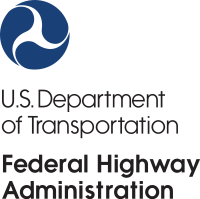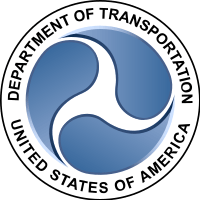Federal Highway Administration
The Federal Highway Administration (FHWA) is a division of the United States Department of Transportation that specializes in highway transportation. The agency's major activities are grouped into two programs, the Federal-aid Highway Program and the Federal Lands Highway Program. Its role had previously been performed by the Office of Road Inquiry, Office of Public Roads and the Bureau of Public Roads.
 Federal Highway Administration logo | |
| Agency overview | |
|---|---|
| Formed | April 1, 1967 |
| Preceding agency |
|
| Jurisdiction | Federal government of the United States |
| Headquarters | Washington, D.C., U.S. |
| Annual budget | $46.0 billion (FY2019)[1] |
| Agency executives |
|
| Parent agency | Department of Transportation |
| Website | www |
History
Background
The organization has several predecessor organizations and a complicated history.
The Office of Road Inquiry (ORI) was founded in 1893. In 1905 that organization's name was changed to the Office of Public Roads (OPR) which became a division of the United States Department of Agriculture. The name was changed again to the Bureau of Public Roads in 1915 and to the Public Roads Administration (PRA) in 1939. It was then shifted to the Federal Works Agency which was abolished in 1949 when its name reverted to Bureau of Public Roads under the Department of Commerce.
With the coming of the bicycle in the 1890s, interest grew regarding the improvement of streets and roads in America. The traditional method of putting the burden on maintaining roads on local landowners was increasingly inadequate. New York State took the lead in 1898, and by 1916 the old system had been discarded everywhere. Demands grew for local and state government to take charge. With the coming of the automobile after 1910, urgent efforts were made to upgrade and modernize dirt roads designed for horse-drawn wagon traffic. The American Association for Highway Improvement was organized in 1910. Funding came from automobile registration, and taxes on motor fuels, as well as state aid. In 1916, federal-aid was first made available to improve post-roads, and promote general commerce. Congress appropriated $75 million over a five-year period, with the Secretary of Agriculture in charge through the Bureau of Public Roads, in cooperation with the state highway departments. There were 2.4 million miles of rural dirt rural roads in 1914; 100,000 miles had been improved with grading and gravel, and 3000 miles were given high quality surfacing. The rapidly increasing speed of automobiles, and especially trucks, made maintenance and repair high-priority item. Concrete was first used in 1893, and expanded until it became the dominant surfacing material in the 1930s.[2][3]
Federal aid began in 1917. From 1917 through 1941, 261,000 miles of highways were built with federal aid, and cost $5.31 billion. Federal funds totaled $3.17 billion, and state-local funds were $2.14 billion.[4]
Creation
The FHWA was created on October 15, 1966.
In 1967 the functions of the Bureau of Public Roads were transferred to the new organization.
It was one of three original bureaus along with the 'Bureau of Motor Carrier Safety' and the 'National Highway Safety Bureau' (now known as National Highway Traffic Safety Administration).[5]
Functions
The FHWA's role in the Federal-aid Highway Program is to oversee federal funds used for constructing and maintaining the National Highway System (primarily Interstate Highways, U.S. Highways and most state highways). This funding mostly comes from the federal gasoline tax and mostly goes to state departments of transportation.[6] FHWA oversees projects using these funds to ensure that federal requirements for project eligibility, contract administration and construction standards are adhered to.
Under the Federal Lands Highway Program (sometimes called "direct fed"), the FHWA provides highway design and construction services for various federal land-management agencies, such as the Forest Service and the National Park Service.
In addition to these programs, the FHWA performs and sponsors research in the areas of roadway safety, congestion, highway materials and construction methods, and provides funding to local technical assistance program centers to disseminate research results to local highway agencies.
The FHWA also publishes the Manual on Uniform Traffic Control Devices (MUTCD), which is used by most highway agencies in the United States. The MUTCD specifies such things as the size, color and height of traffic signs, traffic signals and road surface markings.
Organization
The Federal Highway Administration is overseen by an administrator appointed by the President of the United States by and with the consent of the United States Senate. The administrator works under the direction of the Secretary of Transportation and Deputy Secretary of Transportation. The internal organization of the FHWA is as follows:[7]
- Administrator
- Executive Director
- Office of Infrastructure
- Office of Research, Development, and Technology
- Public Roads magazine
- Office of Planning, Environment, and Realty
- Office of Policy and Government Affairs
- Office of the Chief Financial Officer
- Office of Administration
- Office of Operations
- Office of Safety
- Office of Federal Lands Highway
- Office of Chief Counsel
- Office of Civil Rights
- Office of Public Affairs
- Executive Director
Long-Term Pavement Performance Program
Long-Term Pavement Performance (LTPP) is a program supported by FHWA to collect and analyse road data. The LTPP program was initiated by the Transportation Research Board (TRB) of the National Research Council (NRC) in the early 1980s. Federal Highway Administration (FHWA) with the cooperation of the American Association of State Highway and Transportation Officials (AASHTO) sponsored the program. As a result of this program, FHWA has collected a huge database of road performance. FHWA and ASCE hold an annual contest known as LTPP International Data Analysis Contest, which is based on challenging researchers to answer a question based on the LTPP data. [8]
Every day counts initiative
The Every day counts initiative (EDC) of the FHWA planned in 2009 and started in 2011 is designed as the United States road infrastructure project of the 2010s decade to identify and deploy innovation aimed at reducing project build delivery time, enhancing safety and protecting the environment.[9][10][11] It also made a positive impact in accelerating the deployment of innovations.[12]
Five steps were scheduled from 2012 to 2020 and include various technologies and methods to improve travel time, safety, project and contract management, saving energy, risks, cost and environment resources.[13]
It started with reducing fuel consumption and improving travel time reliability by Adaptive traffic control, continued with implementing alternative intersections design and several money savings and anti-corruption strategies like independent reviewing of construction plans before construction is paid, also time saving strategies like right-of-way, on site bridge constructions as rapid bridge replacement.[14]
Administrators
|
|
Deputy administrators
- D. Grant Mickle October 27, 1961 [17] – January 20, 1964
- Lowell K. Bridwell (acting) January 20, 1964 – March 23, 1967[18]
- Ralph Bartelsmeyer August 10, 1970 – January 25, 1974 [19]
- Joseph R. Coupal Jr September 30, 1974 [20] – ?
- Karl S. Bowers June 5, 1977[21] – August 3, 1978[22]
- John S. Hassell, Jr. August 31, 1978 – July 11, 1980
- Alinda Burke August 8, 1980[23] – ?
- Lester P. Lamm September 17, 1982 – 1986
- Gloria J. Jeff December 19, 1997[24] – January 3, 1999[25]
- Dr Walter Sutton Jr (acting) January 3, 1999[26] – May 3, 2000[27] May 3, 2000 – January 2001
- J. Richard Capka August 5, 2002 – May 31, 2006 [28]
- Kerry O'Hare November 10, 2008 [29] – January 20, 2009
- Gregory G. Nadeau July 8, 2009 – July 30, 2014
- Brandye Hendrickson July 24, 2017 – October 9, 2019
- Mala Parker October 10, 2019 to Present [30]
Executive directors
See also
- Federal Motor Carrier Safety Administration
- Highway Gothic
- Title 23 of the Code of Federal Regulations
- Intelligent Transportation Systems
- Intelligent Transportation Systems Institute
- National Transportation Communications for Intelligent Transportation System Protocol (NTCIP)
- U.S. Department of Transportation
- American Association of State Highway and Transportation Officials
References
- https://www.congress.gov/116/bills/hjres31/BILLS-116hjres31enr.pdf
- Harold U. Faulkner, The Decline of Laissez Faire, 1897-1917 (1951) pp 233-36.
- Charles Lee Dearing, American highway policy (1942).
- The total GNP at current prices, 1917 through 1941 = $2,227.2 billion, so these roads = 5.32/2.227.2 = 1/4 of 1% of GNP. US Bureau of the Census, Historical Statistics of the United States (1976) pp 224, 711, series F1, Q 64-Q68
- "Public Roads - Highway Existence: 100 Years and Beyond, Autumn 1993". fhwa.dot.gov.
- "What is the Highway Trust Fund, and how is it financed?". Tax Policy Center. Retrieved March 18, 2020.
- "FHWA Organization - Federal Highway Administration". www.fhwa.dot.gov. Retrieved March 15, 2018.
- "Transportation & Development Institute (T&DI) Of The American Society Of Civil Engineers (ASCE) and Long-Term Pavement Performance (LTPP) International Data Analysis Contest". fhwa.dot.gov.
- Schroeder, Bastian; Cunningham, Chris; Ray, Brian; Daleiden, Andy; Jenior, Pete; Knudsen, Julia (August 2014). Diverging Diamond Interchange Informational Guide (PDF). Washington, DC: Federal Highway Administration Office of Safety.
- "EDC-1: Adaptive Signal Control Technology". Federal Highway Administration.
- Dowsett, Emily (January 31, 2019). "APWA Announces Public Policy Priorities for 116th Congress" (Press release). American Public Works Association – via GlobeNewswire News Room.
- "FHWA Launches Fifth Round of 'Every Day Counts' Program". For Construction Pros.
- Therrien, Alan J. (January 1, 2018). Performance Measures for Alternative Project Delivery Methods on Highway Transportation Projects (Masters thesis). Boulder: University of Colorado Boulder.
- "Every day counts initiative". Federal Highway Administration.
- https://www.fhwa.dot.gov/byday/fhbd0125.htm
- https://www.fhwa.dot.gov/about/org/admin.cfm
- https://www.fhwa.dot.gov/byday/fhbd1027.htm
- https://www.fhwa.dot.gov/byday/fhbd0323.htm
- "January 25 - FHWA By Day - Highway History - Federal Highway Administration". www.fhwa.dot.gov.
- https://www.fhwa.dot.gov/publications/publicroads/14novdec/03.cfm
- https://www.jimmycarterlibrary.gov/digital_library/sso/148878/85/SSO_148878_085_11.pdf#page=31
- https://www.fhwa.dot.gov/byday/fhbd0803.htm
- https://www.fhwa.dot.gov/byday/fhbd0808.htm
- https://www.fhwa.dot.gov/byday/fhbd1219.htm
- https://www.ttnews.com/articles/top-fhwa-official-jeff-resigns
- https://web.archive.org/web/20180810050448/http://www.carsandracingstuff.com/library/calendar/calendar_thisdayinautomotivehistory.php
- https://www.fhwa.dot.gov/byday/fhbd0515.htm
- "Public Roads - Along The Road, November/December 2002 -". www.fhwa.dot.gov.
- https://web.archive.org/web/20180810050448/http://www.carsandracingstuff.com/library/calendar/calendar_thisdayinautomotivehistory.php
- https://www.fhwa.dot.gov/about/org/depadmin.cfm
- https://web.archive.org/web/20180810050448/http://www.carsandracingstuff.com/library/calendar/calendar_thisdayinautomotivehistory.php
- https://www.fhwa.dot.gov/about/org/exdir.cfm
External links
| Wikimedia Commons has media related to Federal Highway Administration. |
